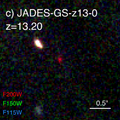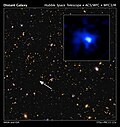Top Qs
Timeline
Chat
Perspective
List of the most distant astronomical objects
From Wikipedia, the free encyclopedia
Remove ads
This article lists the most distant astronomical objects discovered and verified so far, and the time periods in which they were so classified.

For comparisons with the years after the Big Bang of the astronomical objects listed below, the age of the universe is currently estimated as 13.787 ± 0.020 billion years.[2] However, the estimated age of the universe has increased over the years as the observational techniques have been refined. For the discovery of IOK-1 in 2006 had an estimate of 13.66 billion years for the age of the universe.[3]
Distances to remote objects, other than those in nearby galaxies, are nearly always inferred by measuring the cosmological redshift of their light. By their nature, very distant objects tend to be very faint, and these distance determinations are difficult and subject to errors. An important distinction is whether the distance is determined via spectroscopy or using a photometric redshift technique. The former is generally both more precise and also more reliable, in the sense that photometric redshifts are more prone to being wrong due to confusion with lower redshift sources that may have unusual spectra. For that reason, a spectroscopic redshift is conventionally regarded as being necessary for an object's distance to be considered definitely known, whereas photometrically determined redshifts identify "candidate" very distant sources. Here, this distinction is indicated by a "p" subscript for photometric redshifts. Apart from most commonly used distance measurements for high redshift objects, an alternative is to calculate how old the object is in relation to the Big Bang and the column "Years after the Big Bang" shows these values.[4]
Remove ads
Most distant spectroscopically-confirmed objects
Remove ads
Candidate most distant objects
Summarize
Perspective
Since the beginning of the James Webb Space Telescope's (JWST) science operations in June 2022, numerous distant galaxies far beyond what could be seen by the Hubble Space Telescope (z = 11) have been discovered thanks to the JWST's capability of seeing far into the infrared.[73][74]
Previously in 2012, there were about 50 possible objects z = 8 or farther, and another 100 candidates at z = 7, based on photometric redshift estimates released by the Hubble eXtreme Deep Field (XDF) project from observations made between mid-2002 and December 2012.[75]
Some objects included here have been observed spectroscopically, but had only one emission line tentatively detected, and are therefore still considered candidates by researchers.[76]
Remove ads
List of most distant objects by type
Summarize
Perspective
Remove ads
Timeline of most distant astronomical object recordholders
Summarize
Perspective
Objects in this list were found to be the most distant object at the time of determination of their distance. This is frequently not the same as the date of their discovery.
Distances to astronomical objects may be determined through parallax measurements, use of standard references such as cepheid variables or Type Ia supernovas, or redshift measurement. Spectroscopic redshift measurement is preferred, while photometric redshift measurement is also used to identify candidate high redshift sources. The symbol z represents redshift.
Remove ads
See also
References
Wikiwand - on
Seamless Wikipedia browsing. On steroids.
Remove ads








































